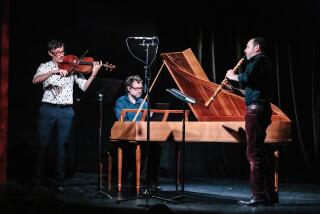MUSIC REVIEW : GENNARO GETS JUMP ON SEASON
- Share via
SAN DIEGO — Even though the city’s various summer pops seasons are over or winding down, a serious chamber ensemble such as the Gennaro Trio is still purveying haute cuisine to a fast-food market. But San Diego’s most intrepid chamber group--and arguably its most skilled--evidently had no qualms in getting a jump on the fall season by playing a program Sunday evening at the First Unitarian Church.
As Sunday’s performance affirmed, the Gennaro Trio’s success is based on a combination of fluent, sympathetic ensemble playing and a refined interpretation of the repertory that precludes neither strength nor emotional commitment.
In the four years that pianist Ilana Mysior, cellist Mary Lindblom and violinist Ronald Goldman have played together, they have garnered a loyal following. Having traversed the canon of Beethoven piano trios last spring at the Unitarian Church, Gennaro left that familiar terrain and treated the faithful to a pair of rare 20th-Century works, the seldom-played Chopin Trio, Op. 8, and Brahms’ autumnal C Minor Trio, Op. 101.
For reasons of audience psychology, most chamber groups sandwich contemporary pieces in the middle of a program, hoping that a familiar work at the end will mitigate the damage. Joachim Stutschewsky’s 1970 “Finale Quasi una Fantasia” made such an impression, however, that when Gennaro returned on stage to play an encore, a voice from the audience shouted, “Play the Stutschewsky again.”
Although the impassioned request was not heeded--Gennaro served up instead the Minuet from Beethoven’s Trio, Op. 1, No. 3--it was evidence of the work’s charm despite its Schoenbergian overtones.
Stutschewsky, a Ukrainian-born Israeli composer, spent time in Vienna in the 1920s, where he encountered Schoenberg’s circle, before he finally settled in Israel. In this later composition, Stutschewsky neatly juxtaposed string solos redolent of Hebrew cantillation, taut Webern-like textures, and sinuous serialist counterpoint. Gennaro gave it an affectionate, telling performance, one that indeed invited a second and third hearing.
Alan Hovhaness’ Trio No. 1, Op. 3, captured all the ethos of the Stutschewsky without any of its intellectual import. Predictably arousing a modal, vaguely middle-eastern tonal palette, the trio bathed the audience in languorous melodies throughout the first two movements and concluded with an awkward fugue in severely academic, neoclassical idiom.
Chopin’s chamber music has never rated a second glance from most cognoscente, although no less than Robert Schuman saw great promise in the Polish pianist’s chamber endeavors. Gennaro gave Chopin’s G Minor Trio a thorough and meticulous reading, one that seemed to last twice as long as the fulsome work’s 30 minutes. No amount of well-intentioned musicianship, however, could redeem this heart-shaped box of musical bonbons.
Gennaro’s Brahms Trio was both majestic and introspective, soaring with the trio’s cohesive, well-balanced sonority, yet inviting deeper reflection in the delicately transparent interludes. Avoiding any temptation to overpower their listeners with Brahms’ latent symphonic overtones, Gennaro constructed an aural temple of Apollonian proportions.
Unlike those one-month-per-year trios composed of stellar soloists and paraded for maximum box office draw, Gennaro’s identity as an ensemble is its most winning virtue. Mysior’s formidable keyboard prowess is the group’s cornerstone; Goldman’s precision and incisive violin gives the group its sharp profile, and Lindblom’s generous cello gives needed heart to the musical equation.
More to Read
The biggest entertainment stories
Get our big stories about Hollywood, film, television, music, arts, culture and more right in your inbox as soon as they publish.
You may occasionally receive promotional content from the Los Angeles Times.










